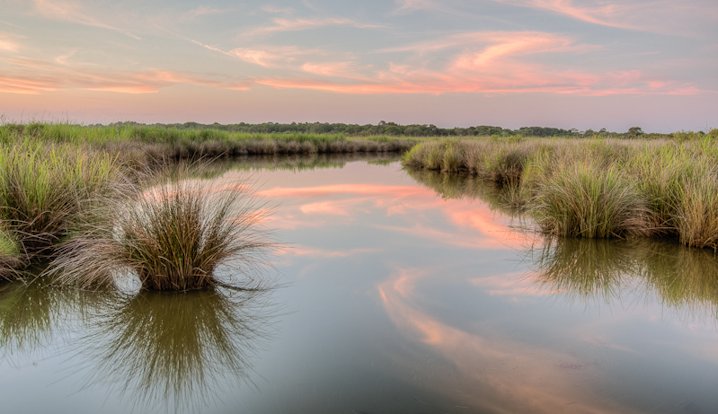
COROLLA — Forty-two years ago, Winston-Salem developer Earl Slick cast the future of the Currituck Outer Banks with his visionary purchase of 636 acres in what is now Pine Island, the first subdivision in Corolla and the genesis of what became a booming upscale resort community.
But Slick also owned pristine land near Pine Island along the Currituck Sound, with a secluded hunt club among the loblolly pines, needle rush and cattails where he retreated to duck hunt with his friends.
Supporter Spotlight
Those 2,600 acres off N.C. 12 are today known as the Donal C. O’Brien Jr. Audubon Sanctuary and Center at Pine Island, and Audubon has a plan to protect them that would likely very much please Slick, who donated his land in 1979 to the nonprofit conservation group.
“I always say we’re preserving the Outer Banks as it used to be,” said Robbie Fearn, the sanctuary’s director, during a recent visit to the site, which Audubon started managing in 2010. “We feel like we can contribute to the life of the community while continuing to manage the property for wildlife.”
Fearn said that the sanctuary has established a steering committee he’s calling the Alliance for Currituck Sound – “an informal group seeking to find common ground and common action.” More than 40 people attended the first meeting in September.

By pulling together people representing different facets of the community – including the UNC Coastal Studies Institute, the U.S. Fish and Wildlife Service, Currituck County and local residents – the hope is that a united vision can be found to preserve the historic and natural assets of the property, as well as restore the environmental balance of the sound and the marsh.
“It’s a globally rare ecosystem,” Fearn said.
Supporter Spotlight
And the first step, he said, is getting the community engaged: What is the current state of the sound? What needs to happen to make it healthier?
“The solution has to be community based, or it won’t last,” he said. “Nobody really likes outsiders to come in and tell them what to do.”
Once a world-renowned mecca for duck hunters, the shallow Currituck Sound attracts one-tenth of the waterfowl it had during the heyday in the early- to mid-20th century. A draft 2011 study by the Army Corps of Engineers determined that increased erosion and salinity has been detrimental to the submerged vegetation in the sound, resulting in murkier water and less food and habitat for fish and birds. No action has yet been taken on the study’s findings.
Every year, Fearn said, about 70 acres of salt marsh erodes away. The south edge of the Audubon property is especially vulnerable because of high wave fetch, boat traffic and the natural shape of the sound. What was once a sandy bottom is now mucky. Some of the marshland has been invaded by phragmites or reeds.
“The underlying ecosystem has taken a hit,” he said. “It’s so unique. It’s primarily a freshwater marsh.”
Still, as many as 30,000 waterfowl overwintered at Pine Island last year.
Alluding to a lawsuit brought by Audubon to limit beach driving at Cape Hatteras National Seashore on Hatteras Island, Fearn acknowledged that the group has been a lightning rod on the Outer Banks. But he said that Audubon has a stake in this community that is different than the stake it has elsewhere, and it wants to be considered a partner, not an adversary.
“The focus of the alliance is really on creating a community consensus on what needs to happen in the sound,” Fearn said. “One of our goals is to serve as a catalyst for change here. I don’t think it’s wise for Audubon to dictate to the local community.”
It can’t hurt that the center’s habitat manager, Chandler Sawyer, is from Currituck County. In fact, his grandfather is Travis Morris, a Currituck native who has written numerous books about Currituck County history and duck hunting.
Audubon has ambitious goals for Corolla, its first nature center in the state: The 1913 hunting lodge, with its still-fragrant heart pine bead board and intact locking liquor cabinets, will be restored to use for meetings and gatherings. Other buildings on the grounds will be repaired and renovated and the garage will be transformed into a dining hall. The eight-bedroom lodge has 14 beds and the cottages have about 20 beds.
Overall, the facility, which includes a recently restored dock overlooking the sound, will be used as a scientific research center; a nature and learning center to be enjoyed on a limited scale by the public, academics and students; a retreat for nature writers, artists and photographers; and a venue available to rent for weddings and other celebrations. Revenue from fees will go toward operation of the facility.
The $1.5 million first phase of the renovation is expected to begin this fall, Fearn said. All the buildings in the flood zone will be raised, and heating and cooling will be done with geothermal units.
“We’re planning to be an active site 60 years from now,” he said. “Basically, the marshes will move in underneath. Buildings will be connected by boardwalks.”
[su_carousel source=”media: 10017,10015,10012,10010,10016,10009,10008″ width=”720″ height=”300″ items=”1″]
Only the three-mile nature trail accessible near the entrance off N.C. 12 is currently open to the public, and kayak trips are available through a private service.
With sea-level rise and climate change having profound effects on bird habitat, Fearn said that the Pine Island center, which has four managed waterfowl impoundments, is considered critically important habitat for survival of a number of the 588 North American bird species. Audubon plans development of pilot techniques to help shorelines stem erosion and bird habitats adapt.
“We’re going to serve as a hub where people can do that sort of research,” he said.
A few years ago in a very controversial move, Audubon sold about 10 acres of oceanfront property that had much more market value than conservation value for their mission, Fearn said. The money from the sale – about $3 million – was put in an endowment fund that is used for management of the Corolla property. Audubon also is in the process of completing acquisition of an easement on more than 4,000 acres behind the Currituck Club.
Currently, operating costs of the center are about $500,000 a year, Fearn said. In addition to the endowment, the center – so far – is supported through donations and grants, but uses no public money.
Fearn, a Raleigh native, was lured back to North Carolina from Alabama in 2013 to manage the center’s transformation. He had been the executive director for four years of the Ruffner Mountain Nature Preserve in Birmingham. Fearn had earned his master of science in environmental communications at Antioch University New England in Keene, N.H. He also served as education director of the Roger Williams Zoo in Providence, R.I., and director of Cape Wildlife Center in Cape Cod, Mass.
But Fearn, 55, is well acquainted with the Outer Banks. In his younger years, he had worked for 13 years on the outdoor musical drama, “The Lost Colony,” as a performer, technician, production stage manager, technical director and assistant director. And he and his wife Pamela founded NEST, the sea turtle rescue group on the Outer Banks.
Today, the couple lives in one of the wooden houses on the Audubon property with their pet red-footed tortoise, Ruby. Ruby was adopted after she was illegally imported into the U.S. When they got her, Fearn says, she fit in a matchbox. Now she is the size of a dinner plate.
“She’s in our will,” he says. “She will outlive us.”
As its name says, the center is a nature sanctuary, specifically for birds. But some duck hunting has to be allowed to maintain the licenses for the duck blinds, Fearn said. That’s the best way to control how much hunting is done at the 29 hunting blinds on their property. Sawyer, the habitat manager, goes out at the proper time and takes some guests.
“The blinds have to be maintained and you have to use them to some level,” Fearn said. Otherwise, people would be able to secure a license for a “float blind” and shoot on their property, he said. “By maintaining our blinds, we’ve in essence created a protected zone.
“It’s a good balance.”








